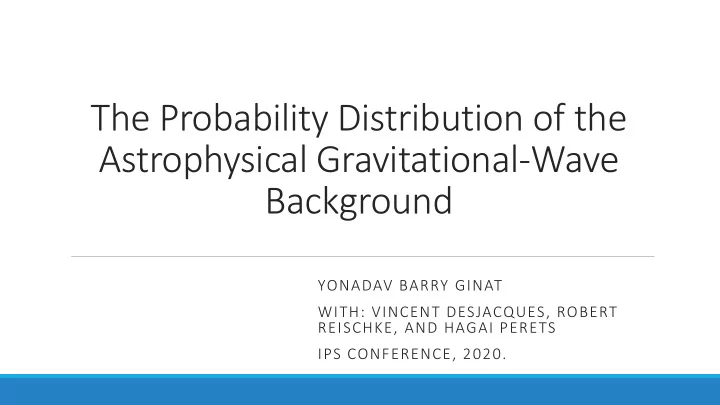

The Probability Distribution of the Astrophysical Gravitational-Wave Background YONADAV BARRY GINAT WITH: VINCENT DESJACQUES, ROBERT REISCHKE, AND HAGAI PERETS IPS CONFERENCE, 2020.
ҧ Gravitational Waves are Space-Time Perturbations • Gravitational waves are tensor perturbations to the space-time metric, defined by 𝑏𝑐 = 𝑏𝑐 + ℎ 𝑏𝑐 . • They satisfy a wave equation 𝐸 𝑑 𝐸 𝑑 ℎ 𝑏𝑐 = − 16𝜌𝐻 𝑈 𝑏𝑐 − 1 2 ҧ 𝑏𝑐 𝑈 𝑑 4 , and their amplitude scales like 𝐸 −1 . • They propagate along null geodesics of ҧ
Source: [7]
What Is the Astrophysical SGWB? • Gravitational waves from all over the universe constantly bathe our detectors, forming a background. • The background is essentially stochastic, due to random nature of emission [5]. • Should be detectable directly with LISA, but current, ground based detectors can only find it with cross- correlations [6].
Modelling The Background is Important • Can teach us about cosmology [e.g. 1,6]. • Can be used to learn about binaries in the Universe, star formation history, phase transitions and even inflation [e.g. 5,6]. • Previous studies focus on power-spectra and implicitly assume Gaussianity [2,4], even for the astrophysical component.
Gravitational Waves Add Like a Random Walk • Treat a wave with amplitude ℎ(𝑢) and phase 𝜚(𝑢) as z = ℎ𝑓 i𝜚 .
Gravitational Waves Add Like a Random Walk • Treat a wave with amplitude ℎ(𝑢) and phase 𝜚(𝑢) as z = ℎ𝑓 i𝜚 . 𝑨 1
Gravitational Waves Add Like a Random Walk • Treat a wave with amplitude ℎ(𝑢) and phase 𝜚(𝑢) as z = ℎ𝑓 i𝜚 . 𝑨 2 𝑨 1
Gravitational Waves Add Like a Random Walk • Treat a wave with amplitude ℎ(𝑢) and phase 𝜚(𝑢) as z = ℎ𝑓 i𝜚 . 𝑨 3 𝑨 2 𝑨 1
Gravitational Waves Add Like a Random Walk • Treat a wave with amplitude ℎ(𝑢) and phase 𝜚(𝑢) as z = ℎ𝑓 i𝜚 . 𝑨 3 𝑨 2 𝑨 1 𝑨 4
Gravitational Waves Add Like a Random Walk • Treat a wave with amplitude ℎ(𝑢) and phase 𝜚(𝑢) as z = ℎ𝑓 i𝜚 . 𝑨 3 𝑨 2 𝑨 1 𝑨 4
Gravitational Waves Add Like a Random Walk • Treat a wave with amplitude ℎ(𝑢) and phase 𝜚(𝑢) as z = ℎ𝑓 i𝜚 . 𝑨 3 𝑨 𝑂 𝑨 2 𝑨 1 𝑨 4 • Total strain from 𝑂(𝑢) sources is position of random walker after 𝑂(𝑢) steps.
Sources Considered Here • Sources are binary black holes or neutron starts. • The wave-form is determined by source parameters 𝜊 which are randomly distributed. • Assume sources are i.i.d, and that they are homogeneously distributed and Poisson-clustered with mean number 𝑂 0 .
Fourier Transform Gives P(h) • Assume initial phases are random. • Then • 𝐻(𝑡) is the single-source characteristic function, given by an expected value of exp i𝑡ℎ 𝑙 (computed as an average over both position and source parameters).
Irregularity of G Determines High-Strain Asymptotics • The large ℎ limit is useful for determining Gaussianity. • The steepest descents method enables one to compute it asymptotically. • By the Paley-Wiener theorem, the irregularity of 𝐻(𝑡) is related to how fast 𝑄 ℎ declines. • Mellin transform approximation of 𝐻(𝑡) at small 𝑡 gives From: [3]
P(h) Has Universal Power-Law Tail • Mellin transform arguments again imply • where 𝑐 3 describes the mean single-source amplitude for a source at origin. • Scaling is universal in-so-far-as it is independent of source parameter distribution details. • Valid for any 𝑂 0 .
From: [3]
Interferences Are Important • Random phases imply that small strains are much more important. • GW luminosity is square of sum of i.i.d. variables, not sum of i.i.d.s. From: [3]
Conclusions and Outlook • A method to calculate the full probability density of the SGWB was presented. • The astrophysical SGWB has a universal scaling at large strains. • It is non-Gaussian for any number of sources. • The method can be extended to frequency space [3]. • In future work assumptions on homogeneity and isotropy of source distribution will be relaxed. • Also in future work: explicit subtraction of bright (i.e. resolved) sources.
Works cited 1. Bertacca et al. (2019), arXiv:1909.11627. 2. Cusin et al. (2017), PRD. 3. Ginat et al. (2019), 1910.04587. 4. Jenkins et al. (2019), arXiv: 1907.06642. 5. Kosenko & Postnov (2000), A&A. 6. Maggiore, Gravitational Waves , vols. 1 (2008) and 2 (2018), OUP. 7. Pössel, Markus, in Einstein-Online https://www.einstein-online.info/en/spotlight/gw_waves/
Recommend
More recommend